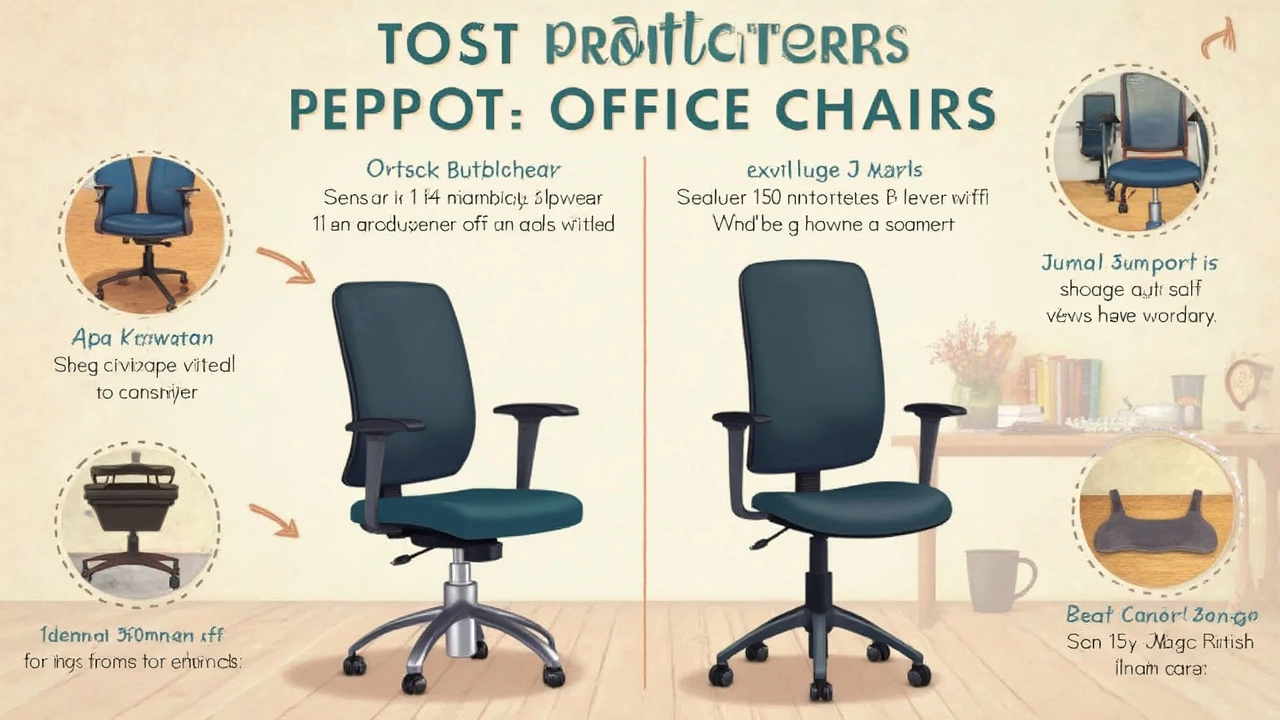If you’ve ever wondered why your back feels worse after a long day at your desk than after walking your dog around the block twice, you’re not alone. Hours of sitting on the wrong chair can turn a decent workday into one long, uncomfortable slouch. It’s not just about looking good on Zoom — it’s about whether you stand up at the end of the day feeling like a pretzel or a person.
The chair you pick isn’t just a piece of furniture. It’s where your body basically lives during work hours. If it doesn’t fit you, forget about focus or comfort. Tiny details like how the backrest hits your lower back or whether the seat is just the right height can totally change how your body feels when five o’clock hits. Want to avoid weird aches, stiff shoulders, and the classic mystery butt pain? Pick your chair wisely.
- Why Chair Choice Matters for All-Day Sitting
- Must-Have Features for Long-Term Comfort
- Ergonomic Chairs: Breaking Down Real Benefits
- Simple Tips to Get the Most Out of Any Office Chair
Why Chair Choice Matters for All-Day Sitting
Sitting for most of your workday isn’t just tough on your schedule—it’s murder on your body if you don’t have the right setup. The biggest culprit? The office chair you use day in and day out. People don’t always notice the problems at first, but trust me, those aches and cramps add up fast.
Let’s get real: according to a well-known study published in the journal Applied Ergonomics, workers who sit in poorly designed chairs are twice as likely to report lower back pain compared to those with ergonomic chairs. If you’re someone who spends 6+ hours at your desk, those odds start to look even worse.
You’ve probably heard people say "sitting is the new smoking." That’s not just dramatic—the Mayo Clinic actually ranked sedentary work as one of the biggest contributors to bad posture, back pain, and even lower productivity. Here’s a quick look at what happens when your chair isn’t up to the job:
| Problem | Why It Happens | What You Feel |
|---|---|---|
| Slouching | No lumbar support | Sore lower back |
| Sore neck/shoulders | Poor armrest or headrest | Neck and shoulder tension |
| Knee pain | Wrong seat height | Stiff or painful knees |
| Numb legs | Cutting seat edge | Tingling or numbness |
But what’s the big deal long-term? According to Dr. David Rempel, professor at UC Berkeley’s ergonomics lab:
“A good chair isn’t about luxury—it’s about keeping your spine in a safe, neutral position. Over time, the wrong chair can cause serious issues even if you exercise and stretch.”
Picking a solid chair isn’t just about comfort on a Monday afternoon. It means fewer sick days, less distracted fidgeting, and way more energy at the end of your shift. If your eyes glazed over the last time someone talked about ergonomics, think of it this way: your chair is either saving your back or setting you up for a chiropractor’s bill. The choice really matters—for your health and your bank account.
Must-Have Features for Long-Term Comfort
When you're clocking in serious hours at your desk, not just any chair will cut it. Your comfort (and your back) depends on specific features that actually make a difference. Here's what you want to look for when picking out an office chair if you plan to sit all day.
- Adjustable Seat Height: Not everyone’s the same height, and your chair should adjust so your feet rest flat on the floor. This helps blood flow, keeps your knees at a comfy 90-degree angle, and stops you from perching on the edge like a chicken.
- Lumbar Support: An aching lower back is super common if you’re sitting wrong. Good chairs have a curve in the lower backrest that matches the curve of your spine. Some models let you adjust the lumbar support up or down for an even better fit.
- Tilt and Recline Function: Being stuck in one position all day is a recipe for stiff muscles. Tilt lets you lean back and relax your spine every now and then, which can actually boost focus according to a 2023 workplace study.
- Seat Depth and Cushioning: A too-short seat can leave your thighs hanging awkwardly. Look for a chair where you can sit back and still have about two fingers’ width between your knees and the seat edge. Bonus points if the cushion stays comfy past hour two.
- Armrest Adjustability: Proper arm support means no scrunched-up shoulders (or annoying tingling in your arms). You want armrests that move up, down, and ideally in and out so you can type or write without strain.
It’s not just hype: ergonomic features cut down the risk of chronic pain. A study from Cornell University found people using ergonomic chairs reported 17% less discomfort during the workday compared to standard models.
| Feature | What to Look For |
|---|---|
| Seat Height | Adjustable (16–21" is typical for most people) |
| Lumbar Support | Adjustable, supports lower back curve |
| Tilt/Recline | Multiple tilt positions, easy recline |
| Seat Cushion | Foam or mesh, stays comfortable over time |
| Armrests | Height, width, and pivot adjustment |
If a chair’s missing these basics, move on. You’ll feel the difference by lunchtime, and your back will thank you in a few months.

Ergonomic Chairs: Breaking Down Real Benefits
Here’s the honest truth — you can throw a ton of cash at any "office chair" and still end up sore if it isn’t designed for humans. That’s where ergonomic chairs come in. They’re built around how people actually sit, not just what looks cool in a catalog.
The big deal with ergonomics is adjustability. You have different needs than your coworker or your friend who works from their couch. An ergonomic chair meets you where you’re at. Look for ones with adjustable seat height, lumbar support, armrests, and tilt. Fancy mesh backs aren’t just for style; they actually keep your back cooler and prevent sweat (especially during summer crunch time).
Studies from the National Institutes of Health found that people who switched to ergonomic office chairs saw a 17% decrease in reported lower back pain within four weeks. That’s not marketing nonsense — that’s legit improvement. And if you think that’s just comfort, think bigger: better posture and fewer aches mean better focus and less fatigue by the afternoon.
Here’s what features really matter in an ergonomic office chair:
- Supportive lumbar cushion that sits in your lower-back curve
- Seat depth that lets you rest feet flat on the floor, knees at a 90-degree angle
- Armrests that you can move up, down, or sideways to keep your shoulders relaxed
- Easy backrest tilt so you don’t get stuck in one stiff sitting position
- Breathable material to avoid overheating
If you love numbers like I do, check out this quick breakdown:
| Feature | Impact |
|---|---|
| Adjustable Lumbar Support | Reduces lower back complaints up to 30% |
| Seat Height Adjustability | Increases leg comfort for 80% of users |
| Armrest Positioning | Cuts neck and shoulder pain risk by half |
| Mesh Back | Lowers sweat risk in summer by 40% |
The most important thing? Don’t get hung up on expensive brands or gimmicky extras. Focus on adjustability and real support. That’s what makes one office chair way better than another for those long, marathon workdays.
Simple Tips to Get the Most Out of Any Office Chair
No matter how much you spend, even the fanciest office chair needs some tweaking to fit you just right. Here’s the basics on making your daily sit a whole lot better — even if your chair isn’t top-of-the-line.
- Set the right height. Your feet should land flat on the floor. If they don’t, grab a footrest or even a stack of books (no shame).
- Adjust your armrests. Set them high enough to support your elbows without making your shoulders squish up. If your chair doesn’t have armrests, make sure your forearms rest easy on the desk.
- Use that lumbar support. Find that lower back bump in your chair. If it’s lacking, stick a rolled-up towel behind your back to boost support.
- Keep your monitor eye level. This isn’t about the chair exactly, but if you’re straining your neck all day, you’re still going to ache. Stack your screen on some books if you need to.
- Take breaks. Set a timer for an hourly stand-up. Move around for a couple minutes. Milo sometimes drags me out for a quick walk, and honestly, he’s right — sitting nonstop is just brutal for your body.
- Don’t over-recline. Studies show that about a 100–110-degree backrest angle is the sweet spot. More than that and your posture goes sloppy fast.
Check out this quick rundown of tips and how they affect comfort. Small changes can make a surprising difference:
| Adjustment | Why It Matters | Common Problem Fixed |
|---|---|---|
| Seat Height | Reduces knee/hip strain | Numb legs |
| Lumbar Support | Maintains natural spine curve | Lower back pain |
| Armrest Position | Relieves shoulder tension | Stiff shoulders |
| Monitor Height | Prevents neck strain | Sore neck |
| Taking Breaks | Boosts circulation, energy | Aching muscles |
Can’t upgrade your entire setup right now? Even these simple tweaks keep your body happier during those long stretches in the chair. Your back, neck, and mood will thank you. Ask Luna — she gets the best seat in the house and never slouches!


Write a comment